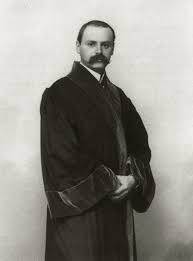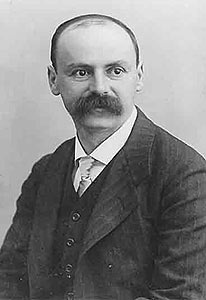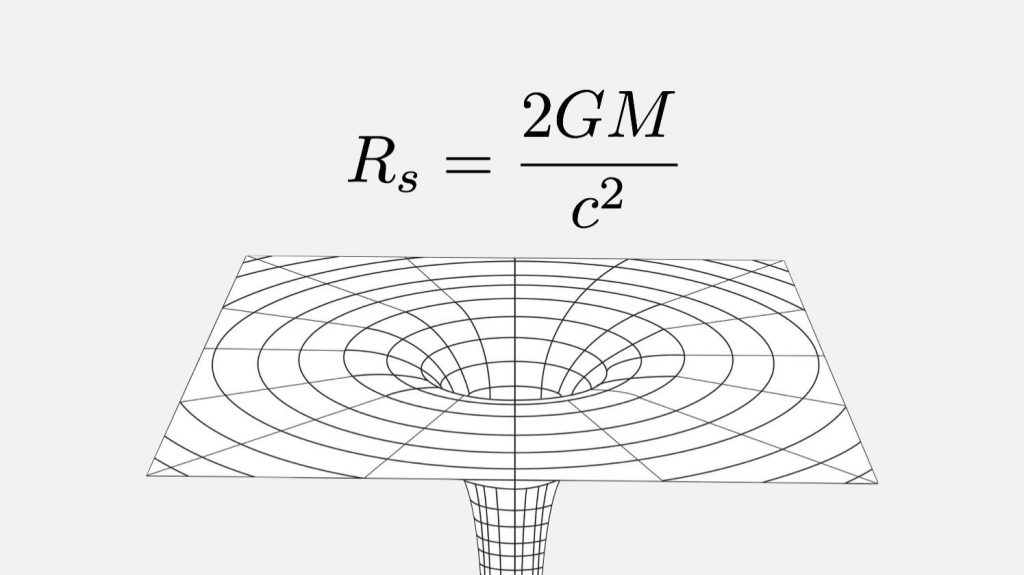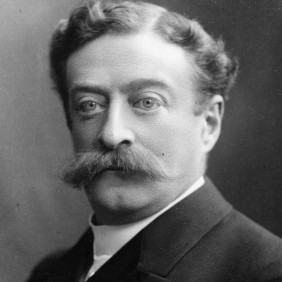


In our Universe, every massive object is associated with five physical quantities. These are the inertial mass, rest mass energy, Compton wavelength, Schwarzschild radius and the standard gravitational parameter. In today’s article, we will try to understand the concept of Schwarzschild radius. So, lets begin!

MEANING OF EQUATION:
The Schwarzschild Radius represents the ability of a mass to cause curvature in space and time. If an object is crushed to a sphere of Schwarzschild radius, its escape velocity will equal that of light and the object will become a black hole.
Thus, the Schwarzschild radius actually represents the ability of a mass to curve the space and time. This quantity actually originated from Einstein’s field equations of general relativity.
Einstein’s picture of the Universe
Before turning to the physical significance of this radius, let us have a quick look at Einstein’s picture of the Universe. According to Albert Einstein, the universe is a fabric of space and time. Newton developed his laws by considering the fact that space and time are absolute. They are same for everyone, no matter where the person is in the Universe. Einstein said No! Time is not absolute. (See this why it isn’t absolute). Space and time are affected by mass. To get a picture of it, look at this image below.

Sun warps the fabric of space and time around it. Earth does that too. But, the magnitude is very less as compared. The difference between the two? Their mass. Thus, massive objects bend more space-time than the lighter ones. Another fascinating feature of this beautiful theory is that even light is affected by this curvature. So the light coming from stars behind the Sun will follow a curved path when that light passes in the vicinity of the Sun. (That’s how General Relativity was proven experimentally).
Importance of Mass Distribution:
Now the amount of bending of light will depend on the space-time curvature which will eventually depend on the mass distribution of that object. Remember, a star of 5 solar masses might not be a black hole but a black hole of 5 solar masses can exist. The difference is that the star has its mass entirely distributed over a large volume. But, in case of a black hole, the entire mass is distributed in a point like singularity. Thus the space-time curvature for a black hole is enormously large.
Mathematical formalism for Schwarzschild radius:
Now what if I have a mass distribution that bends the space-time curvature so much that even the fastest entity in this universe, light, gets trapped around that object? For this to happen, the escape velocity of that object (the minimum velocity required to break through the gravitational potential of an object) will equal that of light. Thus the kinetic energy (1/2 mv^2) will be equal to gravitational potential energy (GMm/R). Equating v = c, the velocity of light, we get the above formula for the Schwarzchild radius. Thus, if anything in this universe is suppressed into a sphere of this radius, it will cause such a tremendous curvature in space time that even light will not be able to escape and thus the object will become a black hole.
Author’s message:
Okay so now when we know the concept and the formula, let us have some fun by plugging the values of different objects in it. For Sun, R is 3 km. So if Sun is compressed into a sphere of radius 3 Km, it will become a black hole. For Earth it is 9 mm. For a human…. I leave that to you: plug in your mass M and find out!
The Schwarzchild radius arises due to singularity term in the Schwarzchild metric of Einstein’s field equation. For advanced study, see Schwarzchild Metric.
Karl Schwarzschild; 9 October 1873 – 11 May 1916) was a German physicist and astronomer. He was also the father of astrophysicist Martin Schwarzschild.
Schwarzschild provided the first exact solution to the Einstein field equations of general relativity, for the limited case of a single spherical non-rotating mass, which he accomplished in 1915, the same year that Einstein first introduced general relativity. The Schwarzschild solution, which makes use of Schwarzschild coordinates and the Schwarzschild metric, leads to a derivation of the Schwarzschild radius, which is the size of the event horizon of a non-rotating black hole.
Schwarzschild accomplished this while serving in the German army during World War I. He died the following year from the autoimmune disease pemphigus, which he developed while at the Russian front. Various forms of the disease particularly affect people of Ashkenazi Jewish origin.
Asteroid 837 Schwarzschilda is named in his honour, as is the large crater Schwarzschild, on the far side of the Moon. https://en.wikipedia.org/wiki/Karl_Schwarzschild
Martin Schwarzschild

Schwarzschild was born in Potsdam into a distinguished German Jewish academic family. His father was the physicist Karl Schwarzschild and his uncle the astrophysicist Robert Emden. In line with a request in his father’s will, his family moved to Göttingen in 1916. Schwarzschild studied at the University of Göttingen and took his doctoral examination in December 1936. He left Germany in 1936 for Norway and then the United States. Schwarzschild served in the US army intelligence. He was awarded the Legion of Merit and the Bronze Star for his wartime service. After returning to the US, he married fellow astronomer Barbara Cherry. In 1947, Martin Schwarzschild joined his lifelong friend, Lyman Spitzer at Princeton University. Spitzer died 10 days before Schwarzschild.
Schwarzschild’s work in the fields of stellar structure and stellar evolution led to improved understanding of pulsating stars, differential solar rotation, post-main sequence evolutionary tracks on the Hertzsprung-Russell diagram (including how stars become red giants), hydrogen shell sources, the helium flash, and the ages of star clusters. With Fred Hoyle, he computed some of the first stellar models to correctly ascend the red giant branch by steadily burning hydrogen in a shell around the core. He and Härm were the first to compute stellar models going through thermal pulses on the asymptotic giant branch and later showed that these models develop convective zones between the helium- and hydrogen-burning shells, which can bring nuclear ashes to the visible surface. Schwarzschild’s 1958 book Structure and Evolution of the Stars taught a generation of astrophysicists how to apply electronic computers to the computation of stellar models.
In the 1950s and ’60s he headed the Stratoscope projects, which took instrumented balloons to unprecedented heights. The first Stratoscope produced high resolution images of solar granules and sunspots, confirming the existence of convection in the solar atmosphere, and the second obtained infrared spectra of planets, red giant stars, and the nuclei of galaxies. In his later years he made significant contributions toward understanding the dynamics of elliptical galaxies. Schwarzschild was renowned as a teacher and held major leadership positions in several scientific societies.
In the 1980s, Schwarzschild applied his numerical skills to building models for triaxial galaxies.
Dr. Schwarzschild was the Eugene Higgins Professor Emeritus of Astronomy at Princeton University, where he spent most of his professional life https://en.wikipedia.org/wiki/Martin_Schwarzschild
Robert Emden

Jacob Robert Emden (4 March 1862 – 8 October 1940) was a Swissastrophysicist and meteorologist. He is best known for his book, Gaskugeln: Anwendungen der mechanischen Wärmetheorie auf kosmologische und meteorologische probleme (Gas balls: Applications of the mechanical heat theory to cosmological and meteorological problems), published in 1907. It presents a mathematical model of the behaviour of polytropic gaseous stellar objects under the influence their own gravity, known as the Lane-Emden equation.
Robert Emden married Klara Schwarzschild, the sister of German physicist and astronomer Karl Schwarzschild and the uncle of the German-American astrophysicist Martin Schwarzschild. They had six children of whom the names of five are known: Charlotte Schein; Emma Müller; Antonia Flach; Karl Emden, and Johanna Luise Berchtold-Emden. Although he married into a strongly scientific family, Robert Emden’s children are not noted for any contributions to science
Emden was an avid balloonist and wrote a book on the principles of balloon navigation in 1910. He always had a practical attitude towards physics, as shown by his 1938 letter to Nature entitled “Why do we have winter heating?” Although he had retired in 1934, Jacob Robert Emden continued his scientific activities until he died in Zürich on 8 October 1940. His final paper on the temperature problems of lakes was in the press at the time of his death. https://en.wikipedia.org/wiki/Robert_Emden
